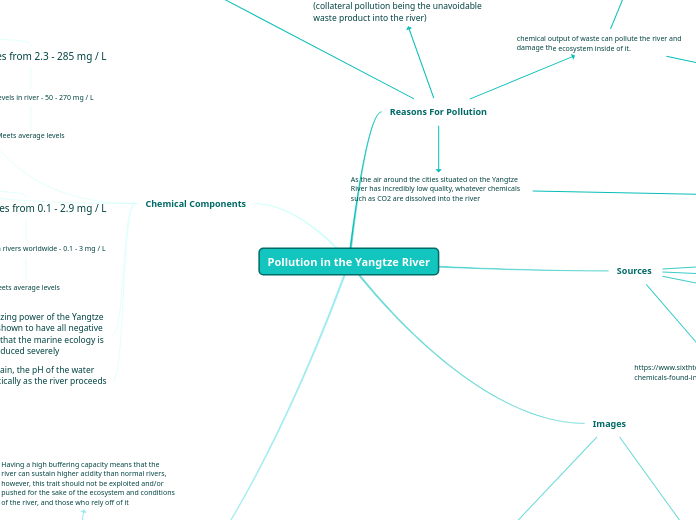Pollution in the Yangtze River
Methods to Resolve Issue
Despite the high acidity of the river, it also appears to have a high buffering capacity
Having a high buffering capacity means that the
river can sustain higher acidity than normal rivers, however, this trait should not be exploited and/or pushed for the sake of the ecosystem and conditions of the river, and those who rely off of it
Some propose that a dam be build to protect homes against flooding.
they will be released in certain periods of time to account for fish breeding seasons.
Some organizations such as WWF (world wide fund for nature) have agreed to contribute to cleaning and aiding the regrowth of the river
The government of China has allowed and will contribute to the cleaning of the Yangtze River
Chemical Components
Because of acid rain, the pH of the water increases dramatically as the river proceeds downstream.
The pH of the water even before polluted areas is already relatively high, with 8.3-9.3 pH
The relative oxidizing power of the Yangtze River (ORP) was shown to have all negative values, meaning that the marine ecology is possibly being reduced severely
ANIONS
NO3- : ranges from 0.1 - 2.9 mg / L
Average levels in rivers worldwide - 0.1 - 3 mg / L
HCO3- : ranges from 25 - 175 mg / L
Average levels in rivers worldwide - 264 mg / L
severely below average
SO2(2-) : ranges from 50 - 250 mg / L
Average levels in rivers worldwide - 250 mg / L
Mostly does not meet average levels
F- : ranges from 0.12 - 0.27 mg / L
Average levels in rivers worldwide - 0.01 - 0.02 mg / L
Severely above average
Cl- : ranges from 40 - 1200 mg / L
Average levels in rivers worldwide - 40 mg / L
CATIONS
K+ : ranges from 2.3 - 285 mg / L
Na+ : ranges from 70 - 650 mg / L
Average levels in river - 50 - 270 mg / L
Mg(2+): ranges from 15- 45 mg / L
Average levels in river - less thatn 20 mg / L
severely above average
Ca(2+): ranges from 42- 72 mg / L
Average levels in river - 1-135 mg / L
Meets average levels
Images
Smog over the Yangtze River
Satellite imagery of the Yangtze River (barely distinguishable from Earth's terrain
Shores/Banks of the Yangtze River
Sources
https://www.sciencedirect.com/science/article/pii/S2405844020304552
https://allthatsinteresting.com/yangtze-river-pollution#7
https://factsanddetails.com/china/cat10/sub66/item391.html
https://www.sixthtone.com/news/1006706/forever-chemicals-found-in-tap-water-along-yangtze-river
Reasons For Pollution
The River floods into populated areas, and can bring materials from urban environments into the Yangtze River in large quantities.
Infrastructure and collateral pollution (collateral pollution being the unavoidable waste product into the river)
The collateral pollutIon is likely higher in the Yangtze River, as more people are likely to output more waste product into the river, however, this is likely not a significant amount compared to avoidable waste products being dumped into the river.
chemical output of waste can pollute the river and damage the ecosystem inside of it.
Chemical makeup of the water changes with a severe increase of certain anions and some cations with levels of mg/L well above what should be in natural rivers worldwide.
This makes it difficult for fish and other marine life to reproduce and start the next generation in the river.
This causes population to decrease dramatically
Reduced population decreases the health of the ecosystem
As the air around the cities situated on the Yangtze River has incredibly low quality, whatever chemicals such as CO2 are dissolved into the river
This decreases the quality of living for any Marine life inside

